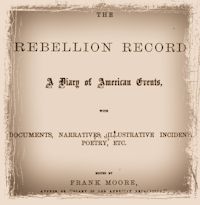October 15.—A fight took place at McLean’s Ford, on Bull Run, Va., between the rebels and the New-Jersey brigade of the Third corps of the army of the Potomac, in which the former lost sixty in killed and wounded, and the latter two killed and twenty-five wounded.—Philadelphia Inquirer, October 22.
—Canton, Miss., was captured by the Union forces under General McPherson, after a severe engagement, in which the rebels lost two hundred in killed, wounded, and prisoners.
—At a special meeting of the Richmond, Va., City Council this evening, a report was adopted appointing a board, consisting of five members of the Council and three citizens, to purchase articles for sale at cost, under their direction, at depots to be established by them, one in each ward. The Council also made an appropriation of fifty thousand dollars for the relief of the poor, and authorized the Finance Committee to sell that amount of confederate State bonds in the city treasury.—The British steamer Mail, having on board a large quantity of cotton and other merchandise, was captured by the United States steamer Honduras, in latitude 27° 57′, longitude 83° 9′.—An entire company of thirty-seven men and three officers, belonging to Gillmore’s rebel battalion, was captured near Hedgesville, Va., day before yesterday, Colonel L. D. Pierce, commanding the forces at Martinsburgh, was informed that Gillmore and his battalion were in the habit of holding frequent picnics through Back Creek Valley, principally for the object of plunder. He accordingly detailed a picket of six men, supplied them with a field-glass, and stationed them upon a prominent point of lookout in the mountains, there to watch, and advise him of any movement that this force might make in that direction. This morning one of the pickets came in and reported the enemy in sight, and a citizen immediately afterward reported a force, numbering from forty to sixty, concealed in the mountains, some two miles from Hedgesville—their intention being to remain there during the day, and burn Back Creek bridge, on the Baltimore and Ohio Railroad, to-night. Colonel Pierce at once despatched a detachment of forty men of the Twelfth Pennsylvania cavalry, under Captain George AV. Henrie, on the Pughtown road, and another of fifty, of the First New-York, under Captain Richard Pendegrass, on the Hedgesville road; the one to flank them on the right, the other on the left. This they did, forming a junction, and very cunningly arranging their lines so as to form two sides of a triangle; while, in the mean time, a company of the One Hundred and Sixteenth Ohio infantry were sent out from North Mountain Station, with orders to attack the enemy directly in front and drive them into the trap so ingeniously laid by the cavalry.
The whole scheme worked charmingly. Upon reaching the woods, the infantry deployed as skirmishers and advanced. They proceeded but a short distance before they came upon the enemy’s camp, and, finding them all napping, with their horses tied to the trees, broke in upon their peaceful slumbers with a very unceremonious volley of musketry, that started a gymnasium among the “rebs,” such as is rarely witnessed in ordinary country shows, the principal feat performed being one known among the chivalry as “right smart git.” They scattered in all directions, leaving their horses behind them, and, in many cases, their hats and arms. The moment the infantry commenced firing, the cavalry closed in upon them, and the whole party permitted themselves to be captured, offering scarcely any resistance. Lieutenant Pierson, of the Twelfth Pennsylvania cavalry, captured nine, including one lieutenant, with no other assistance than that of his sabre.
The officers captured gave their names as Captain William Digges, First Lieutenant John Blackford, and Second Lieutenant Eugene Reed. The prisoners frankly admitted that it was a portion of their programme to burn Back Creek bridge, and do such other damage to the railroad as might come under the head of their mission. No casualties occurred on the Union side. The enemy reported from three to four killed and two wounded.—Baltimore American.


